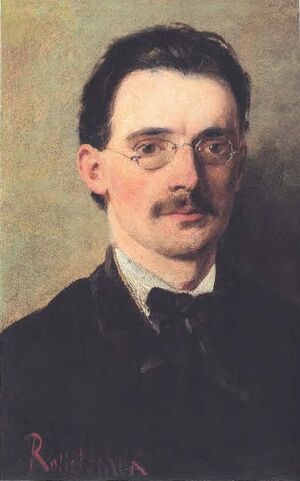Josef Rolletschek: Difference between revisions
mNo edit summary |
mNo edit summary |
||
| (4 intermediate revisions by the same user not shown) | |||
| Line 1: | Line 1: | ||
'''Josef Rolletschek''' (also Josef Rollet, * 1859 in Gießaus in the municipality of Liberk; † 1934 in Weimar) was an Austrian painter who is considered a representative of the Weimar School of painting. | [[File:Josef Rolletschek - 1899 - Die Vertriebenen.JPG|thumb|Josef Rolletschek's 1899 painting "Die Vertriebenen" (The displaced persons) in the Deutsches Historisches Museum, Berlin.]] | ||
[[File:Rudolf Steiner - Joseph Rolletschek 1894 Weimar.jpg|thumb|[[Rudolf Steiner]] (1861-1925), painting by [[Joseph Rolletschek]], 1894 Weimar]]'''Josef Rolletschek''' (also Josef Rollet, * 1859 in Gießaus in the municipality of Liberk; † 1934 in Weimar) was an Austrian painter who is considered a representative of the Weimar School of painting. | |||
Josef Rolletschek studied at the Academy of Fine Arts in Prague under František Sequens from 1883 to 1890. From 1890, he lived in the artists' home in Weimar and studied from 1891 to 1896 at the Grand Ducal Saxon School of Art in Weimar under Carl Frithjof Smith. | Josef Rolletschek studied at the Academy of Fine Arts in Prague under František Sequens from 1883 to 1890. From 1890, he lived in the artists' home in Weimar and studied from 1891 to 1896 at the Grand Ducal Saxon School of Art in Weimar under Carl Frithjof Smith. | ||
Rolletschek was a friend of Rudolf Steiner, the later founder of anthroposophy, and painted his portrait. Rolletschek also wrote the book "Was sich die Blumen erzählen und Anderes". In addition to his own works, Rolletschek created several copies of old portraits of prominent personalities, including Friedrich II of Prussia after the original by Anna Rosina de Gasc and Anna Amalia of Prussia after the original by Angelika Kaufmann. | Rolletschek was a friend of [[Rudolf Steiner]], the later founder of [[anthroposophy]], and painted his portrait. Rolletschek also wrote the book "Was sich die Blumen erzählen und Anderes". In addition to his own works, Rolletschek created several copies of old portraits of prominent personalities, including Friedrich II of Prussia after the original by Anna Rosina de Gasc and Anna Amalia of Prussia after the original by Angelika Kaufmann. | ||
His paintings can be found in the collections of the Stadtmuseum Weimar and the National Gallery in Prague, among others. | His paintings can be found in the collections of the Stadtmuseum Weimar and the National Gallery in Prague, among others. | ||
| Line 9: | Line 10: | ||
== Publications == | == Publications == | ||
* ''Was sich die Blumen erzählen und Anderes''. Wigand, Leipzig/Berlin 1904 | * ''Was sich die Blumen erzählen und Anderes''. Wigand, Leipzig/Berlin 1904 | ||
== Literature == | |||
* Wolfgang G. Vögele (ed.): ''Der andere Rudolf Steiner. Augenzeugenberichte, Interviews, Satiren''. Pforte, Dornach 2005, ISBN 3-85636-158-8, S. 64ff. | |||
== Weblinks == | |||
{{Commonscat}} | |||
* [http://kalliope-verbund.info/de/eac?eac.id=1046730959 Rolletschek, Josef] – Kalliope | |||
* [http://www.onbenaco.com/de-de/161/pinacoteca.aspx View of Torbole on Lake Garda] | |||
* [http://www.worldcat.org/identities/viaf-306273712/ WorldCat-Identity] | |||
{{DEFAULTSORT:Rolletschek, Josef}} | {{DEFAULTSORT:Rolletschek, Josef}} | ||
| Line 17: | Line 27: | ||
[[Category:1934 deaths]] | [[Category:1934 deaths]] | ||
[[Category:Man]] | [[Category:Man]] | ||
[[de:Josef Rolletschek]] | |||
Latest revision as of 07:44, 20 March 2024


Josef Rolletschek (also Josef Rollet, * 1859 in Gießaus in the municipality of Liberk; † 1934 in Weimar) was an Austrian painter who is considered a representative of the Weimar School of painting.
Josef Rolletschek studied at the Academy of Fine Arts in Prague under František Sequens from 1883 to 1890. From 1890, he lived in the artists' home in Weimar and studied from 1891 to 1896 at the Grand Ducal Saxon School of Art in Weimar under Carl Frithjof Smith.
Rolletschek was a friend of Rudolf Steiner, the later founder of anthroposophy, and painted his portrait. Rolletschek also wrote the book "Was sich die Blumen erzählen und Anderes". In addition to his own works, Rolletschek created several copies of old portraits of prominent personalities, including Friedrich II of Prussia after the original by Anna Rosina de Gasc and Anna Amalia of Prussia after the original by Angelika Kaufmann.
His paintings can be found in the collections of the Stadtmuseum Weimar and the National Gallery in Prague, among others.
Publications
- Was sich die Blumen erzählen und Anderes. Wigand, Leipzig/Berlin 1904
Literature
- Wolfgang G. Vögele (ed.): Der andere Rudolf Steiner. Augenzeugenberichte, Interviews, Satiren. Pforte, Dornach 2005, ISBN 3-85636-158-8, S. 64ff.
